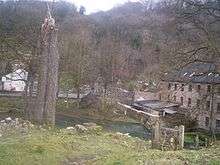Via Gellia
Via Gellia is a steep-sided wooded dry valley and road in Derbyshire.
It is probably named after (or by) Phillip Eyre Gell in a mock-Latin style; he was responsible for building the road through the valley, and the Gells claimed Roman descent. At its lower (eastern) end is the village of Cromford, near the town of Wirksworth and the Georgian cotton mill, Cromford Mill, built by inventor and entrepreneur Richard Arkwright. At the western end is the hamlet of Grangemill.
The road (now the A5012) appears to have been constructed about 1790 to connect the Gell family's extensive lead-mining interests around Wirksworth with a new smelter at Cromford. However, some sources say that the route was in use as early as 1720 for transporting stone from the Gell family's quarries in the Hopton area.
The fabric Viyella, a wool and cotton mix, is named after the Via Gellia valley, the location of W. Hollins & Company's textile mill where it was originally produced.
Modern history
In modern times the Via Gellia developed a reputation as being a dangerous road with a disproportionately high casualty rate, particularly among motorcyclists. This was due in part to its relative narrowness, the number of large goods vehicles using it to access the quarries, and its canopy of overhanging trees resulting in a persistently damp surface. Remedial measures, including resurfacing, were carried out by Derbyshire County Council in 2006.
In World War I, the name Via Gellia was assigned to a communication trench between Kemmel village and the British and Canadian front lines facing the German front lines before Wijtschate in Belgium.
